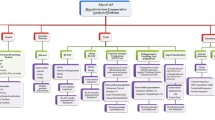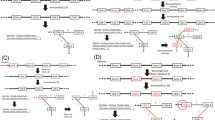Abstract
Mycobacterium tuberculosis (M. tuberculosis) is one of the most widely spread human pathogenic bacteria, and it frequently exchanges pathogenesis genes among its strains or with other pathogenic microbes. The purpose of this study was to screen the pathogenicity islands (PAIs) in M. tuberculosis using the genomic barcode visualization technique and to characterize the functions of the detected PAIs. By visually screening the barcode image of the M. tuberculosis chromosomes, three candidate PAIs were detected as MPI-1, MPI-2 and MPI-3, among which MPI-2 and MPI-3 were known to harbor pathogenesis genes, and MPI-1 represents a novel candidate. Based on the functional annotations of Pfam domains and GO categories, both MPI-2 and MPI-3 carry genes encoding PE/PPE family proteins, MPI-2 encodes the type VII secretion system, and MPI-3 encodes genes for mycolic acid synthesis in the cell wall. Some of these genes were already widely used in early diagnosis or treatment of M. tuberculosis. The novel candidate PAI MPI-1 encodes CRISPR-C as family proteins, which are known to be associated with persistent infection of M. tuberculosis. Our data represents a molecular basis and protocol for comprehensive annotating the pathogenic systems of M. tuberculosis, and will also facilitate the development of diagnosis and vaccination techniques of M. tuberculosis.


Similar content being viewed by others
References
Gazdik MA, McDonough KA (2005) Identification of cyclic AMP-regulated genes in Mycobacterium tuberculosis complex bacteria under low-oxygen conditions. J Bacteriol 187:2681–2692
Sanz J, Navarro J, Arbués A, Martín C, Marijuán PC, Moreno Y (2011) The transcriptional regulatory network of Mycobacterium tuberculosis. PLoS ONE 6:e22178
Gogarten JP, Townsend JP (2005) Horizontal gene transfer, genome innovation and evolution. Nat Rev Microbiol 3:679–687
Pallen MJ, Wren BW (2007) Bacterial pathogenomics. Nature 449:835–842
Fernández-Gómez B, Fernàndez-Guerra A, Casamayor EO, González JM, Pedrós-Alió C, Acinas SG (2012) Patterns and architecture of genomic islands in marine bacteria. BMC Genom 13:347
Hacker J, Blum-Oehler G, Mühldorfer I, Tschäpe H (1997) Pathogenicity islands of virulent bacteria: structure, function and impact on microbial evolution. Mol Microbiol 23:1089–1097
Sui SJH, Fedynak A, Hsiao WWL, Langille MGI, Brinkman FSL (2009) The association of virulence factors with genomic islands. PLoS ONE 4:e8094
Becq J et al (2007) Contribution of horizontally acquired genomic islands to the evolution of the tubercle bacilli. Mol Biol Evol 24:1861–1871
Yu G et al (2011) Integrative analysis of transcriptome and genome indicates two potential genomic islands are associated with pathogenesis of Mycobacterium tuberculosis. Gene 489(1):21–29
Boyd EF, Almagro-Moreno S, Parent MA (2009) Genomic islands are dynamic, ancient integrative elements in bacterial evolution. Trends Microbiol 17:47–53
Karlin S (2001) Detecting anomalous gene clusters and pathogenicity islands in diverse bacterial genomes. Trends Microbiol 9:335–343
Veyrier F, Pletzer D, Turenne C, Behr MA (2009) Phylogenetic detection of horizontal gene transfer during the step-wise genesis of Mycobacterium tuberculosis. BMC Evol Biol 9:196
Juhas M, van der Meer JR, Gaillard M, Harding RM, Hood DW, Crook DW (2009) Genomic islands: tools of bacterial horizontal gene transfer and evolution. FEMS Microbiol Rev 33:376–393
Karlin S, Mrazek J, Ma J, Brocchieri L (2005) Predicted highly expressed genes in archaeal genomes. Proc Natl Acad Sci USA 102:7303–7308
Zhou F, Olman V, Xu Y (2008) Barcodes for genomes and applications. BMC Bioinform 9:546
Bateman A et al (2004) The Pfam protein families database. Nucleic Acids Res 32:D138–D141
Götz S et al (2008) High-throughput functional annotation and data mining with the Blast2GO suite. Nucleic Acids Res 36:3420–3435
Wang G, Zhou F, Olman V, Li F, Xu Y (2010) Prediction of pathogenicity islands in enterohemorrhagic Escherichia coli O157:H7 using genomic barcodes. FEBS Lett 584:194–198
Gal-Mor O, Finlay BB (2006) Pathogenicity islands: a molecular toolbox for bacterial virulence. Cell Microbiol 8:1707–1719
Lawrence JG, Ochman H (1998) Molecular archaeology of the Escherichia coli genome. Proc Natl Acad Sci 95:9413
Mrazek J, Bhaya D, Grossman AR, Karlin S (2001) Highly expressed and alien genes of the Synechocystis genome. Nucleic Acids Res 29:1590–1601
Lima-Mendez G, Van Helden J, Toussaint A, Leplae R (2008) Prophinder: a computational tool for prophage prediction in prokaryotic genomes. Bioinformatics 24:863–865
Letek, M et al (2010) The genome of a pathogenic rhodococcus: cooptive virulence underpinned by key gene acquisitions. PLoS Genet 6(9):e1001145
Cole ST (1999) Learning from the genome sequence of Mycobacterium tuberculosis H37Rv. FEBS Lett 452:7–10
Freitas-Vieira A, Anes E, Moniz-Pereira J (1998) The site-specific recombination locus of mycobacteriophage Ms6 determines DNA integration at the tRNA(Ala) gene of Mycobacterium spp. Microbiology 144(Pt 12):3397–3406
Mao F, Dam P, Chou J, Olman V, Xu Y (2009) DOOR: a database for prokaryotic operons. Nucleic Acids Res 37:D459–D463
Marraffini LA, Sontheimer EJ (2010) CRISPR interference: RNA-directed adaptive immunity in bacteria and archaea. Nat Rev Genet 11:181–190
Arnvig K, Young D (2012) Non-coding RNA and its potential role in Mycobacterium tuberculosis pathogenesis. RNA Biol 9:427–436
Bryant J, Chewapreecha C, Bentley SD (2012) Developing insights into the mechanisms of evolution of bacterial pathogens from whole-genome sequences. Future Microbiol 7:1283–1296
Sampson SL (2011) Mycobacterial PE/PPE proteins at the host-pathogen interface. Clin Dev Immunol 2011:1–11
Delogu G et al (2006) PE_PGRS proteins are differentially expressed by Mycobacterium tuberculosis in host tissues. Microb Infect 8:2061–2067
Rachman H et al (2006) Unique transcriptome signature of Mycobacterium tuberculosis in pulmonary tuberculosis. Infect Immun 74:1233–1242
Singh KK, Dong Y, Patibandla SA, McMurray DN, Arora VK, Laal S (2005) Immunogenicity of the Mycobacterium tuberculosis PPE55 (Rv3347c) protein during incipient and clinical tuberculosis. Infect Immun 73:5004–5014
Koh KW, Soh SE, Seah GT (2009) Strong antibody responses to Mycobacterium tuberculosis PE-PGRS62 protein are associated with latent and active tuberculosis. Infect Immun 77:3337–3343
Singh PP, Parra M, Cadieux N, Brennan MJ (2008) A comparative study of host response to three Mycobacterium tuberculosis PE_PGRS proteins. Microbiology 154:3469–3479
Raman K, Yeturu K, Chandra N (2008) targetTB: a target identification pipeline for Mycobacterium tuberculosis through an interactome, reactome and genome-scale structural analysis. BMC Syst Biol 2:109
Barrett T et al (2012) BioProject and BioSample databases at NCBI: facilitating capture and organization of metadata. Nucleic Acids Res 40:D57–D63
Finn RD et al (2010) The Pfam protein families database. Nucleic Acids Res 38:D211–D222
Conesa A, Gotz S, Garcia-Gomez JM, Terol J, Talon M, Robles M (2005) Blast2GO: a universal tool for annotation, visualization and analysis in functional genomics research. Bioinformatics 21:3674–3676
Acknowledgments
This work was supported by National Natural Science Foundation of China (81101295 and 81071424), Specialized Research Fund for the Doctoral Program of Higher Education of China (20110061120093), China Postdoctoral Science Foundation (20110491311 and 2012T50304), Foundation of Jilin Provincial Health Department (2011Z049),Foundation of Jilin Provincial Science and Technology Department (20130522013JH), Norman Bethune Program of Jilin University (2012219). It was also supported in part by the Shenzhen Research Grant ZDSY20120617113021359, China 973 program (2011CB512003 and 2010CB732606-6) and NSFC 31000447. Computing resources were partly provided by the Dawning supercomputing clusters at SIAT CAS.
Author information
Authors and Affiliations
Corresponding authors
Electronic supplementary material
Below is the link to the electronic supplementary material.
Rights and permissions
About this article
Cite this article
Xie, J., Zhou, F., Xu, G. et al. Genome-wide screening of pathogenicity islands in Mycobacterium tuberculosis based on the genomic barcode visualization. Mol Biol Rep 41, 5883–5889 (2014). https://doi.org/10.1007/s11033-014-3463-4
Received:
Accepted:
Published:
Issue Date:
DOI: https://doi.org/10.1007/s11033-014-3463-4




